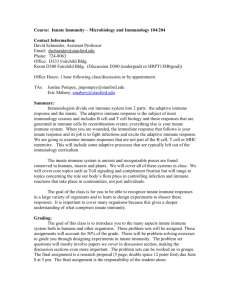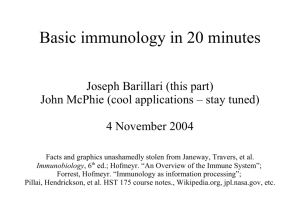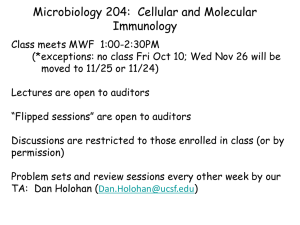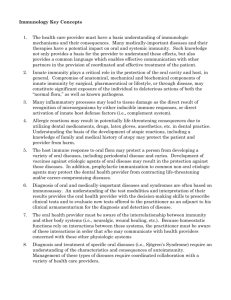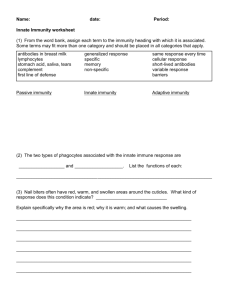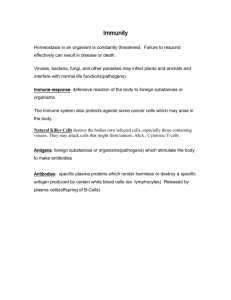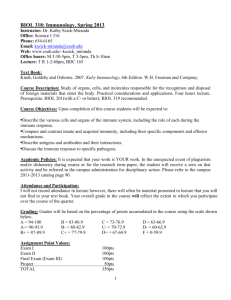Immune System
advertisement
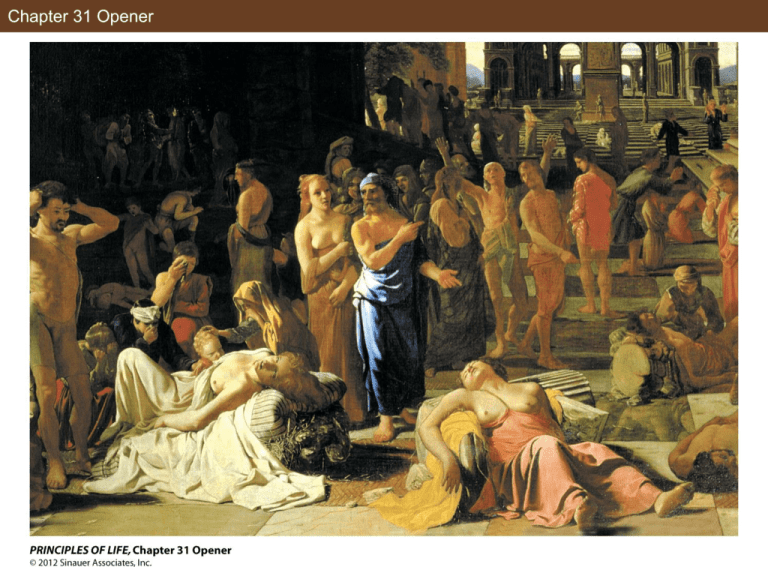
Chapter 31 Opener Table 31.1 Innate and Adaptive Immune Responses to an Infection Figure 31.1 White Blood Cells Figure 31.2 Innate Immunity Figure 31.2 Innate Immunity In-Text Art, Ch. 31, p. 623 (1) In-Text Art, Ch. 31, p. 623 (2) Figure 31.3 Interactions of Cells and Chemical Signals Result in Inflammation Figure 31.3 Interactions of Cells and Chemical Signals Result in Inflammation Concept 31.1 Animals Use Innate And Adaptive Mechanisms to Defend Themselves against Pathogens Innate vs. adaptive immunity Working in pairs and without looking at your notes, identify whether each item below is characteristic of innate immunity and/or adaptive immunity: 1. Barriers such as skin 2. Antibodies 3. Phagocytes 4. Lysozyme 5. B cells 6. Complement system 7. Distinguishing “self” from “non-self” 8. T cells 9. Lymphocytes 10. Interferon 11. Always “ready to go”; does not need time to develop 12. Mucus 13. Found only in vertebrates 14. Can retain a “memory” of previous infections Concept 31.1 Animals Use Innate And Adaptive Mechanisms to Defend Themselves against Pathogens Innate immunity includes a. B cells. b. lymphocytes. c. phagocytes. d. Both a and b e. Both b and c Concept 31.2 Innate Defenses Are Nonspecific Inflammation: helping or hurting? Working in small groups, review the following common symptoms of inflammation that occur after tissue injury. Identify the proximate cause of each symptom (for example, what exactly causes the injured tissue to become warm, red, etc.). Then discuss whether you think each symptom is adaptive—that is, does the symptom help speed wound healing or help defend against infection? • Heat • Redness • Pain • Swelling Finally, consider the following question: Many athletes, after an injury, immediately take action to reduce the symptoms of inflammation, with treatments such as compression bandages, ice, aspirin or anti-inflammatory drugs. Given what you have discussed, do you think it is always a good idea to try to reduce symptoms of inflammation after an injury? Concept 31.2 Innate Defenses Are Nonspecific Which of the following statements about inflammation is false? a. Mast cells release prostaglandins. b. Dilation of blood vessels causes swelling and heat. c. Natural killer cells release histamine. d. Histamine increases the permeability of blood vessels. e. Aspirin blocks prostaglandin synthesis. Figure 43.7 Immunological memory Figure 31.14 Vaccination Figure 43.6 Clonal selection Figure 43.10 An overview of the immune responses (Layer 4) In-Text Art, Ch. 31, p. 625 In-Text Art, Ch. 31, p. 625 Figure 31.4 The Discovery of Specific Immunity Figure 31.4 The Discovery of Specific Immunity Figure 31.4 The Discovery of Specific Immunity (Part 1) Figure 31.4 The Discovery of Specific Immunity (Part 2) Figure 31.5 Clonal Selection in B Cells Figure 31.5 Clonal Selection in B Cells Figure 31.6 The Adaptive Immune System Figure 31.6 The Adaptive Immune System Figure 31.6 The Adaptive Immune System (Part 1) Figure 31.6 The Adaptive Immune System (Part 2) Apply the Concept, Ch. 31, p. 629 Concept 31.3 The Adaptive Immune Response Is Specific Antibody production Suppose you were exposed to a new cold virus when you walked in to lecture today. Your body has never encountered this particular virus before. The virus is now circulating in your body, and is encountering B and T cells. Working in pairs or small groups, discuss what would happen to your ability to produce antibodies against this virus if you… 1. have no helper T cells at all? (Assume you still have other types of T cells.) 2. have no B cells at all? 3. have B and T cells, but due to a genetic mutation, your developing B and T cells never rearranged their DNA? 4. cannot produce any memory cells? (That is, suppose all of your activated B cells become plasma cells, and none become memory cells.) 5. have a genetic mutation such that none of your B cells will divide when activated? (Assume the B cells are otherwise normal and functional.) Which of the above two scenarios will produce the same (or very similar) symptoms? Explain. Concept 31.3 The Adaptive Immune Response Is Specific If no helper T cells are present, a. antibodies will be produced normally. b. a few antibodies will be produced, but not as many as normally would be produced. c. no antibodies will be produced. d. I don’t know. Concept 31.4 The Adaptive Humoral Immune Response Involves Specific Antibodies Build your own immunoglobulin! Suppose you’re a developing lymphocyte. You are about to start randomly shuffling your DNA to build a “supergene” that you will use to make an immunoglobulin chain. You have a chromosome that contains following DNA regions: V1-V2-V3-V4-V5-V6…D1-D2-D3-D4-D5-D6 • Roll the dice to select one of the V regions. • Roll the dice again to select one of the D regions. Write down your final combination of gene segments (e.g., V3-D2, or whatever it is). You have just spliced these gene segments together! This is the final combination of your immunoglobulin chain. Review with a friend: • What will you do with your immunoglobulin chain? (Secrete it? Put it in your membrane?) Review the different types of immunoglobulins and their functions. • Real B cells have 100 V genes, 30 D genes, and 6 J genes for heavy chains, and a similar amount of diversity for light chains. How many possible combinations are there of light chain + heavy chain? Concept 31.4 The Adaptive Humoral Immune Response Involves Specific Antibodies Which of the following cell types produces large numbers of antibodies? a. Helper T (TH) cell b. Cytotoxic T (TC) cell c. Plasma cell d. Memory cell e. Both a and c Concept 31.5 The Adaptive Cellular Immune Response Involves T Cells and Their Receptors MHC proteins Working in pairs, review the differences between Class I MHC proteins and Class II MHC proteins. Discuss: • Which type of cell expresses Class I? Class II? • What type of antigen is presented on each class? • Which type of T cell will bind? • What will the T cell do? Concept 31.5 The Adaptive Cellular Immune Response Involves T Cells and Their Receptors Which of the following statements is true about Class II MHC proteins? a. They are found on macrophages. b. They are used to present intracellular protein fragments. c. Cytotoxic T cells will bind to them. d. Once a T cell binds to them, the antigen-presenting cell is destroyed. e. I don’t know. Figure 31.7 The Structure of an Immunoglobulin Figure 31.7 The Structure of an Immunoglobulin (Part 1) Figure 31.7 The Structure of an Immunoglobulin (Part 2) In-Text Art, Ch. 31, p. 630 In-Text Art, Ch. 31, p. 630 Figure 31.8 Heavy-Chain Genes Figure 43.16 Effector mechanisms of humoral immunity Figure 43.17 The classical complement pathway, resulting in lysis of a target cell Figure 31.8 Heavy-Chain Genes Figure 31.9 Heavy-Chain Gene Recombination and RNA Splicing Figure 31.9 Heavy-Chain Gene Recombination and RNA Splicing Figure 31.10 A T Cell Receptor Figure 31.10 A T Cell Receptor Figure 31.11 Macrophages Are Antigen-Presenting Cells Figure 31.11 Macrophages Are Antigen-Presenting Cells In-Text Art, Ch. 31, p. 634 In-Text Art, Ch. 31, p. 634 Table 31.2 The Interaction between T Cells and Antigen-Presenting Cells Figure 31.12 Tregs and Tolerance Figure 31.12 Tregs and Tolerance Figure 43.18 Mast cells, IgE, and the allergic response Figure 31.13 The Course of an HIV Infection Figure 31.13 The Course of an HIV Infection


